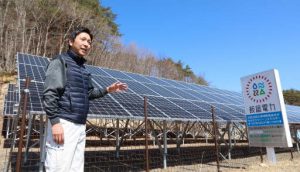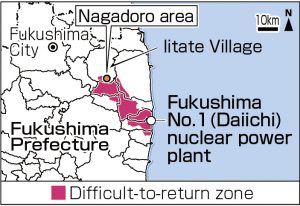Accounts of 50 local Fukushima residents 10 years on, Part 3: Challenge for Iitate Village
Mar. 13, 2021
Amid lingering damage, seeking path to recovery
by Seiji Shitakubo, Staff Writer
Ten years ago, not a single day passed without hearing the name Iitate Village in Fukushima Prefecture. The mountain village, with a population of about 6,500 residents, had flourished because of its livestock industry, but it became caught up in an unexpected human-driven environmental disaster caused by the nuclear accident at the Fukushima No. 1 (Daiichi) nuclear power plant, operated by the Tokyo Electric Power Company. Radioactive materials were carried for more than 30 kilometers on the wind and rain, forcing evacuation of the entire village.
Aged population makes up 70 percent of population
While the evacuation order for most of the village of Iitate was lifted in the spring of 2017, only about 1,500 people, or 20 percent of the former population, now live in the village. Kenta Sato, 39, manages a metalworking company in the village and leads the village’s youth activities. “Those who have come back are mainly older people. The aged population makes up 70 percent of the total. It could be said that the nuclear accident, which changed the shape of the village, persists today,” said Mr. Sato.
After the accident, Mr. Sato called on villagers to write down what they had eaten and how long they had stayed outside every day as something that could be done to prepare for any health problems that might appear. “I referred to the appeals made by the A-bombed cities of Hiroshima and Nagasaki. The two cities have communicated the horror of internal exposure for many years.” Mr. Sato, along with residents who wanted to help, created pocket notebooks for recording such behavior, distributing them free of charge in the fall of 2011.
One other person in Iitate also turned to the knowledge accumulated in the A-bombed city of Hiroshima. Around the time of the accident, Takumi Aizawa, 49, a Fukushima Prefecture government employee, said, “All villagers should be surveyed regarding internal exposure as soon as possible.”
Mr. Aizawa is now seriously ill. He wrote to us about his thoughts — “Some people ask if radiation has something to do with my disease. I’ve been keeping silent, because if I myself say so, I’ll be attacked on the internet.” A-bomb survivors have also been tormented by heartless words and prejudice.
Pending issue of Nagadoro area
Villagers say one pending issue is the handling of the Nagadoro area, entry into which is restricted. At the end of last year, the Japanese government introduced a system that allows the government to lift evacuation orders without decontamination being conducted even in designated “difficult-to-return zones,” such as Nagadoro. However, this only happens if radiation doses decrease to a certain level and the area can be utilized without any human habitation.
The Japanese government and the Tokyo Electric Power Company have stressed in particular the concept of Fukushima reconstruction. It appears to Hachiro Sato, 69, a member of the village council, that “the perpetrators selfishly want to emphasize the beginning of the end of the nuclear accident.” The village has yet to reach a conclusion regarding whether to use the system.
The village council will hold its regular session through March 19. Kenta Sato was present at the plenary session. He was elected to the village council for the first time in 2017 with the backing of his friends and acquaintances.
“I want to make the village a base of production for renewable energy. We have all the requisite land for solar panels and can get our hands on plentiful wood chips,” stressed Mr. Sato. He was also engaged in the preparations for establishment of the local electricity power company Iitate Power, which was funded by villagers and local companies and began solar power generation in 2015.
Mr. Sato said, “This village has been damaged by energy produced in a nuclear power plant. We want to use renewable energy as an ace up our sleeve to literally renew our village.”
(Originally published on March 13, 2021)









